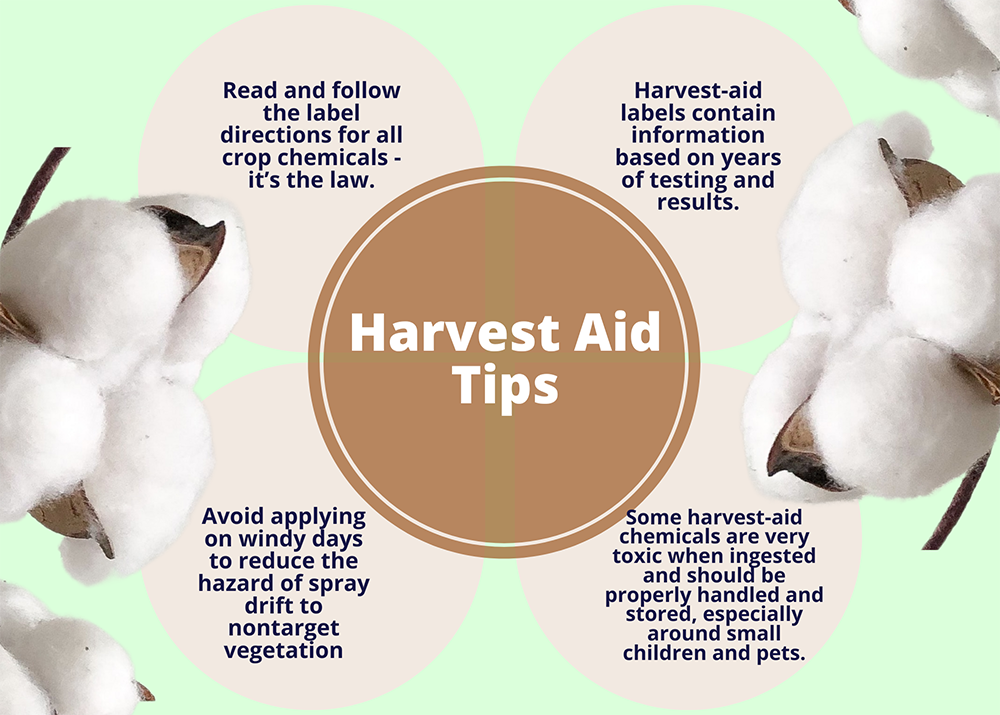Welcome to the October 13, 2023 issue of Cotton News, a service provided by Plains Cotton Growers Inc. for the cotton industry in the Texas High Plains and beyond.

Texas High Plains Harvest Aid Considerations
As presented by Kerry Siders, Extension Agent – Integrated Pest Management for Cochran, Hockley and Lamb Counties
As we move into harvest season, it may be time to consider and apply harvest aids to your crop to reduce potential losses of lint yield and fiber quality. Kerry Siders, IPM agent for Cochran, Hockley and Lamb Counties, presented information on harvest aids to the Plains Cotton Advisory Group this morning (October 13), where he emphasized that harvest aids can result in earlier harvest, preservation of fiber quality and fewer seed quality reductions due to field exposure.
“Weathering losses in the High Plains can result in considerable reduction in dollar value of the crop unless measures are taken to protect yield and quality potential,” he said. “This is especially true for open boll picker-type cotton varieties.”
Factors that increase the performance of harvest-aid chemicals include:
- Weather
- Warm
- Sunny
- Calm
- No fronts anticipated four to five days after application
- Soil
- Low moisture
- Low nitrogen levels
- Plant
- Active leaves that are uniformly expanded on plants
- Little or no secondary growth evident on plants
- Plants with a high percentage of open bolls that have shed some mature leaves
However, there are also factors that can negatively affect the performance of harvest aid chemicals. Along with the polar opposite of the above positive factors, improper calibration of application rates and poor spray coverage can negatively impact the performance of your harvest aids.

Crop Maturity
Crop maturity determination is also critical for a successful harvest-aid program, Siders added. Premature crop termination has been shown to reduce lint yield, seed quality, micronaire and fiber strength.
These chemicals generally terminate fiber and plant development rather abruptly, as they are intended to accelerate harvest of a mature crop. Something important to note that Siders emphasized is that harvest-aid chemicals cannot increase the rate of fiber development.
“Only additional good growing weather including open skies and adequate heat units combined with functional leaves can mature cotton bolls,” he added.
While you can predict through a percentage of open bolls (some say 40% to 60% open bolls is a good sign to start applying harvest aid chemicals), Siders says this is a subjective approach.
Best method for determining maturity:
- Use a sharp knife to cut into the bolls.
- If the boll is watery or “jelly-like” on the inside, then it is immature and needs more heat units.
- If boll development is such that the knife cannot slice through the lint, then the boll is nearly mature.
- Close inspection of the seed will give further indication of boll maturity. If the seed coat is turning tan and the seed leaves (or cotyledons) are fully developed, the boll is mature.
Harvest Aid Application Timing
The Nodes Above Cracked Boll (NACB) method is another tool Siders discussed to help time harvest aid application.
When the crop has four or fewer nodes above cracked boll it is ready for a boll opener (ethephon) and a defoliant application.
For more information, read the Texas High Plains Cotton Harvest Aid Guide here.